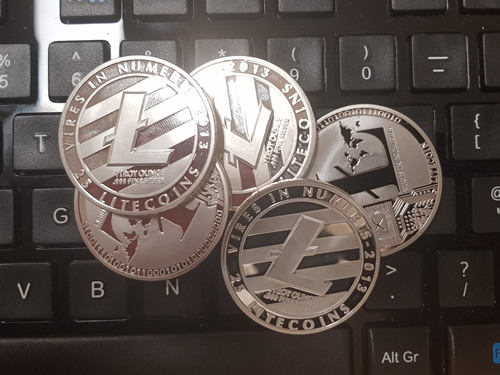Litecoin

Litecoin was one of the first digital currencies to follow Bitcoin’s blueprint and succeed in gaining a lot of traction and trust from users while setting itself apart from the plethora of clones and pump and dump schemes that flooded the market in recent years.
Since the creation of Bitcoin and its revolutionary blockchain technology less than a decade ago, the general interest in digital currencies has reached heights that not even the most fervent enthusiasts could have envisioned. The craze over cryptocurrencies has not only sent Bitcoin’s value through the roof, it has also provided a fertile ground for the creation of similar alternatives.
What exactly is Litecoin and how does it differ from Bitcoin?
Created by former Google engineer Charles Lee in 2011, Litecoin’s goal was to improve on some of the aspects of the Bitcoin ecosystem. With the vision of becoming the silver to Bitcoin’s gold, the founder sees both currencies as coexisting units that complement each other with Litecoin’s value virtually pegged to Bitcoin’s. This approach differs greatly from the one adopted by a multitude of altcoins that attempted to take on Bitcoin head-on at its strength and without offering anything particularly new or innovative.
Litecoins are generated through a process called mining. Just like other currencies that make use of blockchain technology, transactions are compiled in digital ledgers referred to as blocks. The verification of the data is accomplished by mining software that solves complex mathematical equations for the network. Blocks are generated every 2.5 minutes and the miners responsible for validating each transaction are rewarded with 50 litecoins. This system is highly efficient in maintaining the currency’s transparency and eliminates the need for any third party intervention or central authority oversight.
At first glance, there is very little that separates Litecoin from its better-known counterpart. They are both decentralized cryptocurrencies whose integrity is maintained through an encrypted blockchain and all transactions are confirmed via a distributed consensus system. Despite sharing the same basic concept and core technology, there are some clear and distinct differences between the two that need to be outlined. Below is a detailed breakdown of the main particularities that differentiate Litecoin from Bitcoin.
Quicker transaction speed
One of the more noticeable differences between the two currencies is the processing speed of the transactions. The amount of time that is needed to verify and validate a Bitcoin transaction is around 10 minutes, while the same process requires no more than 2.5 minutes on the Litecoin network. Everyday users may not find this disparity to be that significant, as transactions on both networks occur in a seemingly instantaneous way. Merchants, on the other hand, might be tempted to opt for Litecoin as faster transaction times would lead to faster-confirmed payments.
The superior processing speed of Litecoin allows it to handle a much higher volume of transactions than what Bitcoin’s network is capable of managing. Furthermore, the faster the block time of a digital currency is, the less the possibility that double spending will occur.
Algorithm differences: SHA-256 VS Scrypt
Bitcoin utilizes the SHA-256 encryption algorithm for verifying the blockchain transactions and calculating the proof of work. It is one of the more complex cryptographic hash functions available and has become the algorithm of choice for a number of cryptocurrencies. The widespread use of SHA-256 has led to the development of numerous sophisticated pieces of hardware that were designed with the sole intention of deciphering the system’s encryptions. This has significantly raised the difficulty level of mining and has put the required equipment out of the reach of individual users on a budget. The overall cost of Bitcoin mining has restricted the activity to large farms with top of the line computing resources.
Litecoin sought to remedy this problem by adopting Scrypt. This algorithm is less complex than the ones used by most cryptocurrencies and has a relatively low difficulty level compared to SHA-256. Confirming the transactions is more memory intensive than it is processor intensive, this limits the use of custom hardware solutions and democratizes the mining process, as affordable CPUs and GPUs are sufficient to undertake the task.
Market cap and price
While market cap is a highly useful and accurate metric for the valuation of companies, it could be a little bit misleading when used to gauge the value of a cryptocurrency. In many cases, the published market cap is simply the number of all available coins multiplied by the current price. This does not factor in the fact that the currency could be highly illiquid and that a significant number of coins is not easily available for exchange. Still, the market cap can give you a rough idea of a currency’s position in the market. Bitcoin holds the lion’s share of the cryptocurrency market with an estimated value more than 15x that of Litecoin which sits behind Ethereum and Ripple in market cap.
While Bitcoin remains the uncontested market leader in the digital currency world, it is worth noting that Litecoin has seen a much bigger jump in price than all other cryptocurrencies, registering an increase of over 7,000% in 2017. Naturally, this significant rise in price could be explained by the bull market rally for digital currencies in general, but few experts have noted that Litecoin’s total number of coins, which is 4x higher than Bitcoin’s 21 million, might have swayed a number of people to invest in the currency. Despite not having any tangible effects on actual value, a higher number of coins can offer more psychological assurance and a sense of affordability.
Conclusion
The surge of Litecoin is a testament to the overall enthusiasm for cryptocurrencies. By offering a more accessible alternative to Bitcoin and providing merchants with faster transactions, it has managed to carve out its own niche in the crypto world. The future of Litecoin looks very promising as long as the general trust and belief in digital currencies remain strong.

